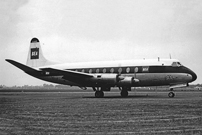
January 1953 to December 1963
British European Airways Corporation (BEA)
G-ALWF - c/n 5 - a V.701 series Viscount
United Kingdom registered
2 January 1953
Registered to British European Airways Corporation (BEA), Keyline House, Ruislip, Middlesex.
19 January 1953
Noted at Christchurch Airfield, Hampshire, England having diverted from Hurn for some reason.
9 February 1953
Certificate of Airworthiness issued by the Air Registration Board.
13 February 1953
Delivered to British European Airways (BEA) named as 'R M A Sir John Franklin'.
It was delivered fitted with Rolls-Royce Dart RDa3 Mark 505 engines with serial numbers: 1016 and 1006 on the port side and 1004 and 1007 on the starboard side.
The cabin was originally fitted out with 40 seats in a four-abreast (2 + 2) all-first class interior, but it was re-configured as a 47 seat all-tourist class layout before it entered service.
It was initially used for crew training and route proving flights.
Vickers-Armstrongs (Aircraft) Ltd, Invoice C/VW/46457, Dated 13 February 1953,
Amount £183,666 2s 11d + £101 7s 5d (delivery fuel + 3% fuel handling charge + oil).
15 March 1953
First noted at Blackbushe Airport, Hampshire, England.
17 April 1953
Full commercial type certification issued to BEA for the V.701 series.
17 April 1953
Ferried to Wisley Airfield, Surrey, England for modification work with Vickers.
19 April 1953
Returned to BEA at London Airport (Heathow), Middlesex, England.
18 April 1953
First Type 701 service commenced from London Airport (Heathow), Middlesex, England to Nicosia Airport, Cyprus via Ciampino Airport, Rome, Italy and Ellinikon Airport, Athens, Greece and was operated by sister Viscount G-AMNY (C/N 6). The Athens - Nicosia leg was operated by Cyprus Airways under a charter agreement with British European Airways (BEA). This was the world’s first regular scheduled service using a turboprop aircraft, and the second one was operated by G-ALWF.
19 April 1953
First V.701 service commenced from London Airport (Heathow), Middlesex, England to Yesilkoy Airport, Istanbul, Turkey.
1953
BRITISH PATHE FILM ARCHIVE
BEA Viscount G-ALWF (c/n 5) arriving at Ciampino Airport, Rome, Italy and G-ALWE (c/n 4) departing.
 British Pathe Film Archive British Pathe Film Archive
14 July 1953
Ferried to Wisley Airfield, Surrey, England for modification work with Vickers.
21 August 1953
Returned to BEA at London Airport (Heathrow), Middlesex, England.
1954 to 1962
The original ‘cutlass’ design propeller blades were gradually replaced by new symmetrical ‘needle’ blade propeller sets.
From photographic evidence, both propeller types were fitted to Rolls-Royce Dart RDa3, Mark 505 and Mark 506 engines and many aircraft flew with an ‘intermix’ of both types of propeller blades.
10 May 1954
Ferried to Wisley Airfield, Surrey, England for modification work with Vickers.
24 May 1954
Returned to BEA at London Airport (Heathrow), Middlesex, England.
12 December 1954
Suffered a partial starboard undercarriage collapse during a crew training landing at Blackbushe Airport, Hampshire, England.
The starboard undercarriage back-stay bracket had failed due to chronic metal fatigue of the bottom attachment bolts.
19 January 1955
The aircraft was dismantled by Eagle Airways Ltd and trucked by road to the Marshall's facility at Teversham Airport, Cambridge, England for repairs.
19 May 1955
Returned to BEA at London Airport (Heathrow), Middlesex, England after the completion of repairs.
May 1955 to December 1956
All BEA V.701 aircraft were gradually retrofitted with Rolls-Royce Dart RDa3 Mark 506 engines which were upgraded using modified Mark 505 engines.
Aircraft are known to have flown with an ‘intermix’ of both engine marks between these dates.
When completely retro-fitted with Mark 506 engines, the Type 701A designation was applied to these aircraft although this has not been seen widely used or quoted.
28 July 1955
After departing from Schiphol Airport, Amsterdam's runway 24 on a flight to London Airport (Heathow), Middlesex, England a bird strike was reported by the flight crew and they elected to return to Schiphol for an inspection, where they found that they had struck a flock of small ducks. Ingestion of birds into the Dart engine can cause a loss of power and blockage of the air fed oil seals.
16 October 1955
Ferried to Teversham Airport, Cambridge, England for modification work with Marshall's.
23 December 1955
Returned to BEA at London Airport (Heathrow), Middlesex, England.
21 May 1956
Undercarriage damaged during a training flight landing at Blackbushe Airport, Hampshire, England.
22 October 1956
Ferried to Wisley Airfield, Surrey, England for wing spar modification work with Vickers.
19 February 1957
Returned to BEA at London Airport (Heathrow), Middlesex, England.
21 January 1958
Noted at Blackbushe Airport, Hampshire, England carrying out crew training flights.
21 March 1958
Burst a tyre at Blackbushe Airport, Hampshire, England during a crew training landing.

BEA
‘Red Square‘ livery
March 1959
A new BEA 'Red Square' livery was adopted and aircraft were repainted during the early 1960s when they next went in for overhaul.
Sadly, after repainting, the aircraft no longer carried a name including the nameplate on the forward cabin bulkhead.
31 March 1959
Converted from 40/47 seats to 60/63 seats in a new 'high density' configuration.
This modification also entailed the installation of an 11th standard size window on the rear starboard side and a small window behind the rear entrance door on the port side.
1 May 1959
Last time it was noted at Blackbushe Airport, Hampshire, England.
1 December 1959
Noted at Gatwick Airport, Surrey, England due to a London Airport (Heathrow) weather diversion.
15 October 1961
Noted at Gatwick Airport, Surrey, England due to a London Airport (Heathrow) weather diversion.
31 March 1963
All BEA V.701 series Viscounts were retired by this date with a fleet total of over 6,000,000 passengers and over 3,000,000 miles.
6 December 1963
Sold to Channel Airways.
 FURTHER READING: Books about BEA - British European Airways FURTHER READING: Books about BEA - British European Airways
|



